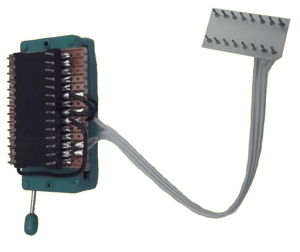 Description
Description Specification
Specification My System Modifications
My System Modifications Games
Games Resources
Resources
Powertran Cortex
 Description
Description
 Specification
Specification
 My System Modifications
My System Modifications
 Games
Games
 Resources
Resources
 |
The Powertran Cortex is a 16-bit TMS 9995-based computer that was available in the UK between about December 1982 and early 1985. The computer could be bought in kit or ready-built forms, and its design was serialised in the Electronics Today International (ETI) magazine between November 1982 and January 1983. Further articles appeared in subsequent issues describing various interface circuits. The computer was manufactured by Powertran Cybernetics Ltd who were based in Andover, Hampshire, UK. The Cortex was developed by TI employees Tony Rowell, Jim Gill, Neil Quarmby, Colin Hinson and Ian White. Tony recalled on a forum dedicated to the system: "The Cortex came about as an extension of a group of us at TI trying to build ourselves a home computer out of 'scrap', remember that at the time a home computer was somewhere between non-existant and insanely expensive. We started of by taking faulty Viewdata boards (sort of Teletext over a dial-up modem) based on the TMS 9980. When the TMS 9995 came out we started looking at building something around that. At that time TI had a minicomputer division (990/12 etc.) and a home computer division (99/4A) with lots of internal politics to ensure that the home computer didn't tread on the minicomputer dept toes so to speak. We however worked for the semiconductor division and just wanted to build something and management just wanted to sell chips. The semiconductor division building a home computer was a big no-no, it would have been stomped on by both the home computer division and the minicomputer division so we had unofficial encouragement to go ahead with the design and the way to 'get it out' was ETI (as long as there was no direct connection to TI). Powertran simply made the kits and sold it. Jim Gill and myself did the BASIC (based on one from TI [TI Power BASIC] but mostly rewritten), Colin Hinson did the debug monitor, Neil Quarmby did the schematics and floppy boot code and Ian White did hardware prototyping and 'resourcing'." The Cortex underwent a facelift around August 1984 into a new slimline case, with a revised PCB which included all the modifications that had accrued since the Cortex was originally published. The disk drives, which were originally fitted in the Cortex case, were now housed in an external enclosure. The revised system was known as the Cortex II. I first came across about the Cortex when I saw the ETI magazine when studying at sixth form college. I copied the articles on the college photocopier and nothing further happened - apart from drooling over it for a while - until I purchased one of six sets of bare Cortex PCBs (still wrapped in the original tissue paper) found at the back of a cupboard and sold on eBay nearly 30 years after production ceased. Building and getting the computer running was straightforward as the system uses no programmable logic ICs and the data to program the system EPROMs is available. The only parts that will be a challenge to obtain are the rare TMX 9909 floppy disk controller, and if you want to use the E-bus expansion interface to its full capability, the 74LS2001 E-bus arbitration controller. (Don't mistake the Powertran Cortex for the Powertran PSI Comp 80 computer, which looks very similar on the outside. The Cortex case is taller, and the numeric keypad is a 3 × 4 arrangement instead of the 4 × 4 arrangement on the PSI Comp 80.) |
A photo of my system is shown below (click photo for larger version, but I'm not very good at photographing PCBs clearly for some reason ...).
The empty IC sockets top right are for the optional E-bus interface ICs, those centre left for the floppy disk interface, and those bottom left for the PAL video circuitry.
I've made a number of (reversible) modifications to my board, as follows:


Available for download below are a couple of games that I have ported to the Cortex. They are in the format used by the PC Comms Utility available on this page, so you'll need to build the simple serial cable described in the zip file to enable transfer from a PC to the Cortex. As I don't have a keyboard on my Cortex, I'm not absolutely sure how smooth control from the keyboard will be - let me know if you give them a try!
This is a port of the TI-99/4A TI Invaders game. Download here. Load by entering the MONitor and using the L command. Leave the IDT field blank when prompted. The game should load at >9000 and auto-run.
The game controls are 'Z' and 'X' to move left and right, and '.' to fire.
You can access a cheat mode when on the title screen by pressing <Shift>838. This prompts for a Y/N to play slow speed then two digits for the number of the screen to start on. None of these inputs will be displayed, and it is not necessary to press <RETURN>.
This is a port of the TI-99/4A Tombstone City game. Download here. Load by entering the MONitor and using the L command. Leave the IDT field blank when prompted. The game should load at >7000 and auto-run.
The game controls are 'E', 'X', 'S' and 'D' to move up, down, left and right, 'G' to start game again, <SPACE> for panic relocation, and <ENTER> to fire.
Port of the April Fool teaser I made for the TI-99/4A. Download here. Load by entering the MONitor and using the L command. Leave the IDT field blank when prompted. The game should load at >6200 and auto-run.
Besides this web page, there are several resources for additional information on the Cortex system:
Link to Powertran Cortex II manual.